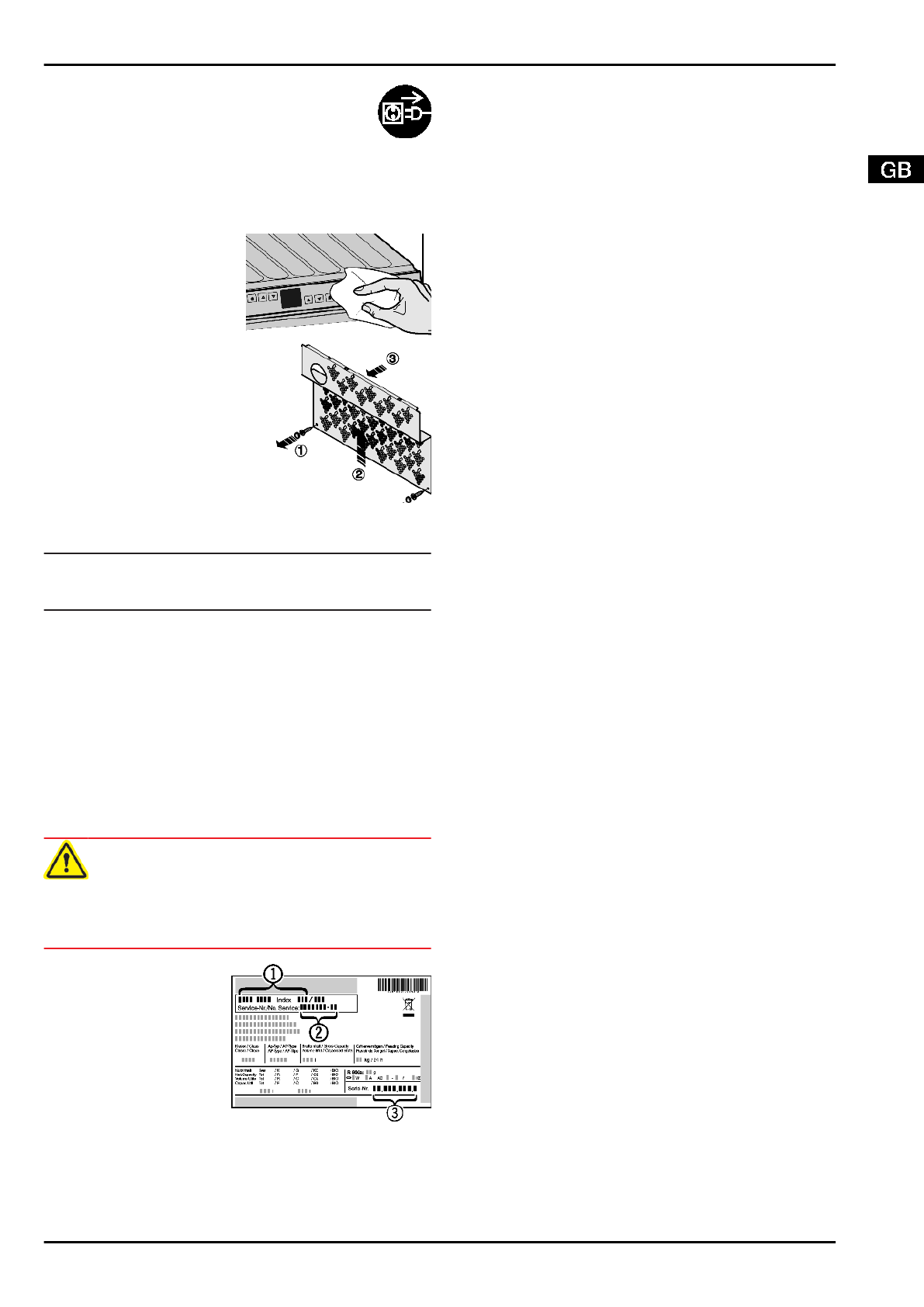Винные шкафы Liebherr WTI 2050 - инструкция пользователя по применению, эксплуатации и установке на русском языке. Мы надеемся, она поможет вам решить возникшие у вас вопросы при эксплуатации техники.
Если остались вопросы, задайте их в комментариях после инструкции.
"Загружаем инструкцию", означает, что нужно подождать пока файл загрузится и можно будет его читать онлайн. Некоторые инструкции очень большие и время их появления зависит от вашей скорости интернета.

u
Empty the appliance.
u
Pull out the plug.
- Use soft cleaning cloths and a multi-purpose
cleaning agent with neutral pH value.
- Only use food compatible cleaning and care agents
on the inside of the appliance.
Interior:
u
Clean the plastic surfaces, outside and inside, by hand using
lukewarm water and a little washing-up liquid.
u
Wipe the rubber lip of the
control panel with a damp
cloth and a cleaning agent
with neutral pH value.
To clean the drain opening:
u
Remove the wooden grid shelves
and detach the pull-out rails.
u
Remove the caps and screws of
the metal cover (1) and side them
aside.
u
Raise the metal cover (2) and draw
it forwards (3).
u
To clean the drain opening:
remove any deposits with a fine
instrument, e.g. a cotton bud.
Items of equipment:
u
Wipe wooden grid shelves with a dry, lint-free cloth.
Note
u
Do not clean wooden grid shelves with water and washing-up
liquid.
u
Clean other items of equipment by hand with lukewarm water
and a little washing-up liquid.
After cleaning:
u
Wipe dry the appliance and items of equipment.
u
Connect the appliance and switch it on again.
u
Put the food back inside.
6.3 Customer service
First check whether you can correct the fault yourself by refer-
ence to the list (see Malfunction). If this is not the case, please
contact the customer service whose address is given in the
enclosed customer service list.
WARNING
Risk of injury if repair work is not carried out professionally!
u
Have any repairs to and intervention in the appliance and
mains power cable, which are not expressly mentioned in the
(see Maintenance) carried out by the customer service only.
u
Read the appliance
designation
Fig. 30 (1), service
No.
Fig. 30 (2) and
serial No.
Fig. 30 (3) off
the type plate located
inside the appliance
on the left-hand side.
Fig. 30
u
Notify the customer service, specifying the fault, appliance
designation
Fig. 30 (1), service No. Fig. 30 (2) and serial No.
Fig. 30 (3).
w
This will help us to provide you with a faster and more accurate
service.
u
Keep the appliance closed until the customer service arrives.
w
The food will stay cool longer.
u
Pull out the mains plug (not by pulling the connecting cable)
or switch off the fuse.
7 Malfunction
Your appliance is designed and manufactured for a long life span
and reliable operation. If a malfunction nonetheless occurs
during operation, check whether it is due to a handling error. In
this case you will have to be charged for the costs incurred, even
during the warranty period. You may be able to rectify the
following faults yourself:
Appliance does not work.
→
The appliance is not switched on.
u
Switch on the appliance.
→
The power plug is not properly inserted in the wall socket.
u
Check power plug.
→
The fuse of the wall socket is not in order.
u
Check fuse.
The compressor runs for a long time.
→
The compressor switches to a low speed when little cold is
needed. Although the running time is increased as a result,
energy is saved.
u
This is normal in energy-saving models.
Excessive noise.
→
Speed-controlled* compressors may produce varying
running noise due to different speed steps.
u
The sound is normal.
A bubbling and gurgling noise.
→
This noise comes from the refrigerant flowing in the refriger-
ation circuit.
u
The sound is normal.
A quiet clicking noise.
→
The noise is produced whenever the refrigeration unit (motor)
automatically switches on or off.
u
The sound is normal.
A hum. It is briefly a little louder when the refrigeration unit
(the motor) switches on.
→
The refrigeration increases automatically when fresh food
has just been placed in the appliance or the door has been
left open for a while.
u
The sound is normal.
→
The ambient temperature is too high.
u
A low hum.
→
The sound is produced by air flow noise of the fan.
u
The sound is normal.
Mould on the wine bottles.
→
Similarly as with other forms of storage, a little mould may
form depending on the type of adhesive used for the label.
u
Remove residual adhesive.
The temperature display indicates:
F0
to
F5
.
→
There is a fault.
u
Contact the customer service (see Maintenance).
The temperature is not cold enough.
→
The door of the appliance is not properly closed.
u
Close the door of the appliance.
→
Insufficient ventilation.
u
Clear ventilation grilles.
→
The ambient temperature is too high.
u
→
The appliance was opened too frequently or for too long.
Malfunction
11
Характеристики
Остались вопросы?Не нашли свой ответ в руководстве или возникли другие проблемы? Задайте свой вопрос в форме ниже с подробным описанием вашей ситуации, чтобы другие люди и специалисты смогли дать на него ответ. Если вы знаете как решить проблему другого человека, пожалуйста, подскажите ему :)

























